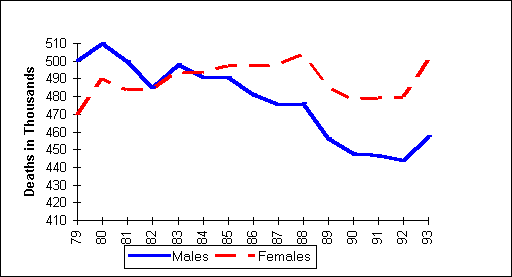
Myth #1:
Basically, it's men who need to worry about CVD, since they have more heart attacks than women.
Leading Causes of Death for Total Females
United States: 1993
CVD = Cardiovascular Diseases
Cardiovascular Disease Mortality Trends for Males and Females, 1979-93

Since 1984 the number of cardiovascular disease deaths for women has exceeded those for men. The difference in deaths currently is more than 43,100.
Final 1993 mortality for cardiovascular disease was 500,387 for women compared with 457,211 for men.
In the United States, all cardiovascular diseases claimed the lives of 500,387 females annually while all forms of cancer killed 250,529 females. (Breast cancer claims the lives of about 43,600 females each year; lung cancer claims another 57,600.)
Medical scientists have made tremendous progress in fighting cardiovascular diseases. Even so, more than 954,000 deaths annually; nearly 42 percent of all deaths every year. In fact, since 1900 the No. 1 killer in the U.S. has been CVD in every year but one (1918).
Deaths don't tell the whole story, either. Of the current U.S. population of about 258 million, more than 57 million people have some form of these diseases. And as the population ages, these diseases may have an even greater human impact. Heart failure, for example, is becoming much more prevalent.
Cancer, AIDS and other diseases deserve research and attention. But it's important to remember that CVD ranks far ahead of them as a cause of death.
Finally, according to the most recent computations, if all forms of major cardiovascular disease were eliminated, life expectancy would rise by almost 10 years. If all forms of cancer were eliminated, the gain would be three years.
People who survive the acute stage of a heart attack have a chance of illness and death that's two to nine times higher than the general population. The risk of another heart attack, sudden death, angina pectoris, heart failure and stroke -- for both men and women -- is substantial. Within six years after a heart attack, 23 percent of men and 31 percent of women will have another heart attack, 41 percent of men and 34 percent of women will develop angina, about 20 percent will be disabled with heart failure, nine percent of men and 18 percent of women will have a stroke, 13 percent of men and six percent of women will experience sudden death.
About two-thirds of heart attack patients don't make a complete recovery, but 88 percent of those under age 65 are able to return to their usual work.